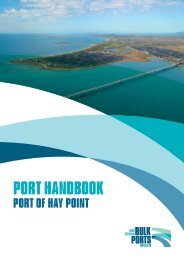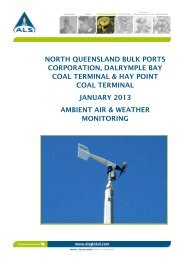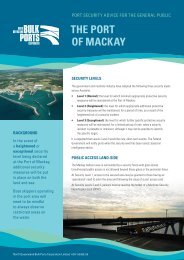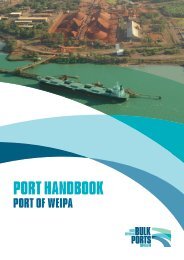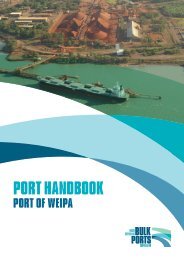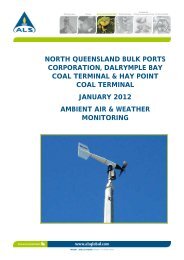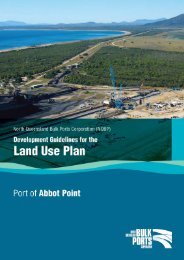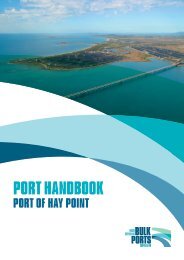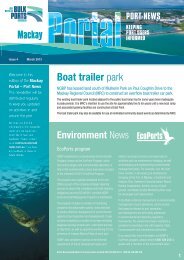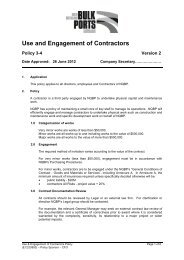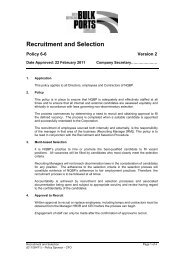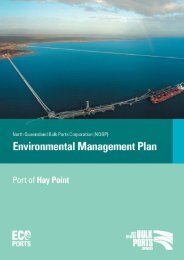Terms of Reference - North Queensland Bulk Ports Corporation
Terms of Reference - North Queensland Bulk Ports Corporation
Terms of Reference - North Queensland Bulk Ports Corporation
- No tags were found...
You also want an ePaper? Increase the reach of your titles
YUMPU automatically turns print PDFs into web optimized ePapers that Google loves.
necessarily limited to) general physical and chemical water quality parameters such asdissolved oxygen, pH, metals and metalloids, nutrients (organic carbon, nitrogen,phosphorus and silicate), temperature, salinity, hydrocarbons, contaminants andturbidity/light attenuation, photosynthetically active radiation (PAR), phytoplanktonpigment analyses, pathogens and parasites.Define and describe the environmental values and water quality objectives, referring to:• EPP (Water) 2009• <strong>Queensland</strong> Water Quality Guidelines (Department <strong>of</strong> Environment and ResourceManagement 2009b)• Australian and New Zealand Guidelines for Fresh and Marine Water Quality(Australian and New Zealand Environment and Conservation Council & Agricultureand Resource Management Council <strong>of</strong> Australia and New Zealand 2000).Dredging and disposalIn the context <strong>of</strong> the DMP,required for development approval under the Coastal Act,describe the method, location and issues associated with both the dredging anddisposal <strong>of</strong> dredge spoil material, including the following:• Undertake two- and three-dimensional sediment plume modelling (as required),including likely dispersion and re-suspension from both dredging operations anddredge spoil disposal during the full range <strong>of</strong> hydrodynamic conditions and weatherevents (including ‘worst case’ conditions). Include a justification <strong>of</strong> the assumptionsand parameters used to model ‘worst case’ conditions, including data source, qualityand any uncertainties.• Describe the proposed marine water quality monitoring regime (receivingenvironment monitoring program—REMP) before, during and after dredging anddisposal, including any required triggers for actions established by a DMP. Provideinformation describing the estimated extent <strong>of</strong> mixing zones for contaminants <strong>of</strong>potential concern.Provide details <strong>of</strong> the physical and chemical qualities <strong>of</strong> likely dredged materials,including the size grading, potential acid sulfate soils (identifying sulfidic or organicsources <strong>of</strong> acidity if detected), contaminants, nutrients, metals and metalloids, andindurated (hardened or cemented) layers.Obtain this information by implementing a sediment sampling and analysis plan (SAP)prepared in accordance with the NAGD (Commonwealth <strong>of</strong> Australia 2009). The EISmust also include a SAP implementation report prepared in accordance with the NAGDand other relevant guidelines.Where possible, present this information as a map <strong>of</strong> sediment types based on theirphysical and chemical properties and include depth pr<strong>of</strong>iles.The criteria used to assess the results <strong>of</strong> acid sulfate soils (ASS) screening tests, toidentify actual ASS (AASS) or potential ASS (PASS), must be taken from the<strong>Queensland</strong> Acid Sulfate Soil Technical Manual. The action criterion from the‘chromium’ suite <strong>of</strong> tests, which triggers a requirement for ASS disturbance to beContents <strong>of</strong> the EISDudgeon Point Coal Terminals Project<strong>Terms</strong> <strong>of</strong> reference for an environmental impact statement- 33 -



